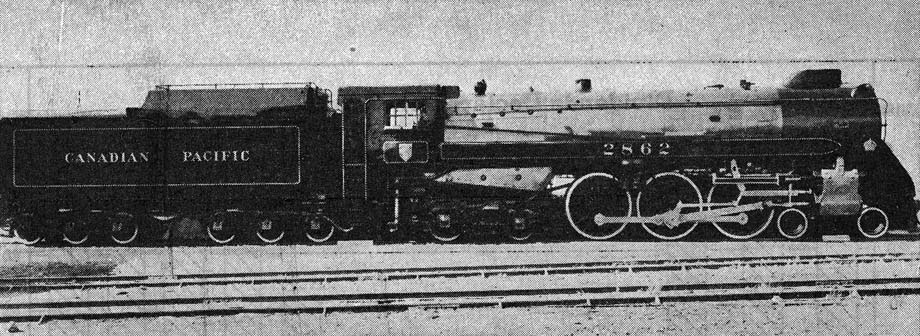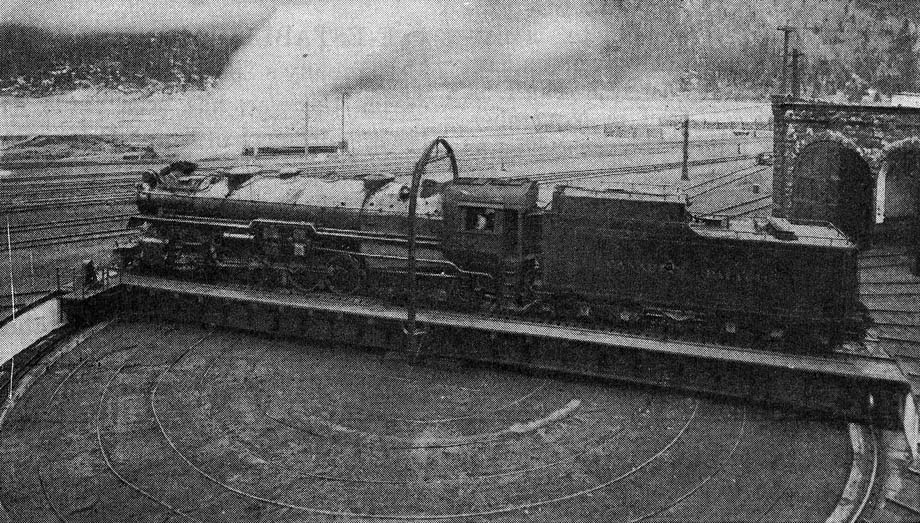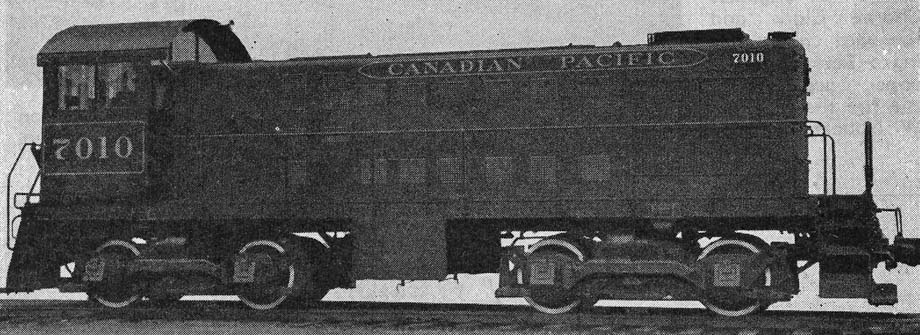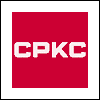
May - 1948
Canadian Pacific Railway
A Study Of Our Motive Power (3 of 3)
By Inventory Classification
By A.E. MIMMS
It is not generally known that the first use of four simple cylinders, with articulated, two unit, driving engines, under a rigid boiler, was originated on the Canadian Pacific Railway in 1911. Previous articulated locomotives on American railways had been built on the Mallet system of compounding, having a rigid rear unit, with high pressure cylinders and a flexible front unit with low pressure cylinders. The modified Mallet engines built by the Canadian Pacific were peculiar in that the front unit was the reverse of the usual practice, having the low pressure cylinders located at the rear of the unit, adjacent to the high pressure cylinders.
The first engine was built in 1909, followed in 1911 by four more compound locomotives, and the simple
engine referred to above. The latter had 20 x 26 inch cylinders with 58 inch driving wheels. These six
locomotives were rebuilt in 1916-1917 to 2-10-0 wheel arrangement, designated as the R2 class. They remain in
service on transfer work in terminal yards.

The wheel arrangement 4-6-4, usually designated as the Hudson type, on account of its general development on the New York Central and Hudson River Railroad, was not originally applied to locomotives for heavy fast passenger service.
The first example of 4-6-4 type used on the Canadian Pacific Railway, was a side-tank suburban passenger locomotive, built by the Canadian Pacific in 1893, with 19 x 22 inch cylinders and 62 inch driving wheels. Additional examples of the side-tank suburban type were built in 1910 and 1912, having cylinders 20 x 26 inches and 63 inch drivers, these were used in the Montreal-Vaudreuil suburban service for many years. None remain in service. The next appearance of the 4-6-4 wheel arrangement was in 1929, when the first Class Hla locomotives were purchased, with 22 x 30 inch cylinders, 75 inch driving wheels, 275 pounds boiler pressure, and developing 45,300 pounds tractive effort.
This successful design was modified and streamlined in 1937, these later being designated as Royal Hudson type to commemorate the Royal Tour of 1939, handled so efficiently by engine number 2856 of the Hld class. Some of the 4-6-4 type locomotives have been fitted with boosters, which increase the starting tractive effort, and also assist maintaining speed when overcoming short grades. The last of the 65 4-6-4 engines still in service were built by the Montreal Locomotive Works, in 1940.
Two side-tank switching locomotives, having an 0-6-4 wheel arrangement, were built by the Canadian Pacific Railway. These engines were generally similar in boiler and running gear to the U3c/d classes of switching locomotives. One of these locomotives is still in existence, but has for several years been used for switching service at an industrial plant.
Ever since 1912, the 2-8-2 Mikado type locomotive has held a prominent place in the Canadian Pacific roster. The original locomotives of this type were built in 1897 for the Nippon Railways, Japan, hence their designation Mikado. The suitability of the 2-8-2 type to meet Canadian conditions is attested by the successful performance of the 5100 series class Pl engines, their further development and extensive use of the larger 5300-5400 class P2 engines, and the present programme, whereby Consolidation 2-8-0 type locomotives are undergoing conversion to 2-8-2 type engines.
The first Pl class locomotives were generally based upon the design of the N3 class engines of 1909, except that the boiler was lengthened, and the firebox supported by a trailing truck of the Vaughhan design. These, trailing trucks, used only on the Canadian Pacific, are the simplest design in use since they require no trailing truck frame. The performance of this kind of truck has been so satisfactory that no other type of two-wheeled trailing truck has been applied to C.P.R. engines. Modernization, of Pl engines, to embody straight line valve motion and improved frames and cylinders was undertaken in March, 1926, and was completed October 1930.
Introduction of a still more modern design of class Pl engines commenced in 1946 when the conversion of class N2 engines presented opportunity to obtain higher boiler pressure and greater power. These locomotives with 22 x 32 inch cylinders, 63 inch diamater drivers, 215 pounds boiler pressure, developing 45,000 pounds tractive effort have given most satisfactory performance under comparative tests. The first of the larger P2a class locomotives was constructed at Angus Shops in 1919, to be followed by successive groups up to the present time.
In 1926, on class P2e, the boiler working pressure was increased from 200 to 250 pounds with cylinder diameter reduced to 23 inches. With class P2g, boiler pressure was increased to 275 pounds and cylinder diameter reduced to 22 inches. This and all later sub classes have similar dimensions viz, cylinders 22 x 32 inch diameter, driving wheels 63 inches, boiler pressure 275 pounds, and tractive effort 57,500 pounds. Twelve class P2k locomotives are now under construction. Of the 287, 2-8-2 Mikado type locomotives added to the inventory, there are at present 283 in service, distributed widely over the entire system.
Three of the locomotives, class Wla were built in 1914, at Angus Shops, and assigned to service in the hump yard at Winnipeg. They have 23 1/2 x 30 inch cylinders, boiler pressure 200 pounds, driving wheels 51 inch diameter and develop 55,200 pounds tractive effort.
Although 4-8-2 type locomotives were widely adopted for passenger service on American railways, only two have been used on the Canadian Pacific. The type originated on the Chesapeake & Ohio Railway in 1911 to handle heavy passenger trains over the Alleghany Mountains. From this the nomenclature Mountain type was evolved.
Three years later, in 1914, the Canadian Pacific built two units at Angus Shops. One was equipped with an especially large firebox and combustion chamber, of the Gaines design, while the other had a standard firebox without combustion chamber. Both had 23 1/2 x 32 inch cylinders, 70 inch drivers, and 200 pounds boiler pressure. Both engines have been scrapped.
The 2-10-0 Decapod type originated in 1867 on the Lehigh Valley Railroad. This unsuccessful locomotive was later converted to 2-8-2 type. The construction of 2-10-0 type engines in 1885 for the Dom Pedro Segundo Railway in Brazil introduced the type nomenclature.
The first 2-10-0 type engines on the Canadian Pacific appeared in 1916 as a conversion from a 0-6-6-0 articulated type. From that date to 1919, a total of 41 locomotives of this type have been built, the latest having 24 x 32 inch cylinders, 58 inch driving wheels, 200 pounds boiler pressure and develop 54,000 pounds tractive effort. Forty are still in service either as helpers on mountainous subdivisions, or in transfer service and yard service
The 2-10-2 type originated on the Atcheson Topeka & Santa Fe Railway in 1903. In 1919, the Canadian Pacific constructed fifteen 2-10-2 type engines for helper and transfer service. These had 26 1/2 x 32 inch cylinders, 58 inch diameter driving wheels, 200 pounds boiler pressure and develop 65,900 pounds tractive effort.
The coal burning locomotives of this class are in transfer service on the Eastern Region, while the oil
burning locomotives have given outstanding service as helpers on the severe grades of the Laggan, Mountain, and
Shuswap Subdivisions. Fifteen of these units still remain in service.

The 2-10-4 type locomotive originated in 1919, on the AT&SF Railway, but was further developed in 1925 for the Texas & Pacific Railway from which the name Texas was derived. Introduced on the Canadian Pacific in 1929, these locomotives were assigned to passenger and freight service on the Mountain Sub between Revelstoke and Field. As additional locomotives were purchased, their operating territory was extended eastward to Calgary.
The first group had 25 1/2 x 32 inch cylinders, 63 inch driving wheels, 275 pounds boiler pressure and developed 77,200 pounds tractive effort. Boosters were afterwards applied to these twenty Tla engines, increasing their starting tractive effort to 89,200 pounds. In 1938 a second group of modernized, streamlined, class Tlb locomotives were purchased. These had 25 x 32 inch cylinders, 63 inch driving wheels, 285 pounds boiler pressure and developed 76,900 pounds tractive effort without booster, 89,400 pounds with booster. There have been few locomotives which have performed so satisfactorily as the Tl class, and at present six more Tlc class engines are under construction.
The handsome appearance of these locomotives, and the mountainous background in which they operate has been so attractive and photogenic that they have been widely publicized by the camera work of newspaper and amateur artists, until they are today, probably the best known locomotives in America.
The 4-8-4 Northern type locomotive, although originated in 1919 on the AT&SF, was not widely accepted until 1927, since which hundreds have been built for use on American railroads, in freight and passenger service. The Canadian Pacific Railway built two in 1928, to handle heavy night trains between Montreal and Toronto, to which duty they are still assigned.

The diesel-electric switcher was introduced on the Canadian Pacific in 1937, when a 0-4-4-0 type switching unit was constructed by the National Steel Car Corp., in which was installed a Harland & Wolff 550 HP two-cycle six cylinder engine, electrical equipment was of English manufacture. This unit was later sold to an industrial concern.
The first of the present standard ALCO 1,000 HP diesel-electric switching locomotives was purchased in 1943. At present 55 of these units are in service.
The last wheel arrangement, or type, to enter the inventory was the 4-4-4 or Jubilee type, so named to commemorate the fiftieth anniversary of Canadian Pacific trancontinental service. Originating in 1935, on the Baltimore & Ohio Ralroad, locomotives of the 4-4-4 type are primarily intended for service on high speed passenger trains, consisting of modern lightweight stream-lined cars. Five class F2a locomotives purchased in 1936, have the largest driving wheels in use on the Canadian Pacific. Their general dimensions comprise 17 1/4 x 28 inch cylinders, and 80 inch diameter driving wheels, 300 pounds, boiler pressure, developing 26,600 pounds tractive effort.
These were followed in 1937-1938 by a group of twenty smaller locomotives of the same wheel arrangement. These have 16 1/2 x 28 in h cylinders, 75 inch drivers, 300 pounds boiler pressure, developing 25,900 pounds tractive effort.
It is possible that future locomotives will follow the trend which influenced the abandonment of the use of steam in the automobile field, and the almost universal acceptance of internal combustion engines for marine transport.
In the United States, adoption of diesel-electric motive power, by the railways, has become so general that production of conventional steam engines has practically ceased.
Steam turbine with direct drive, Steam turbine with electric drive, Diesel-electric, and various designs of gas-turbine electric locomotives are either in service, or in the advanced stages of experimental development. These promise advantages in operating economics which are difficult to secure with steam locomotives of the usual types.
This record, therefore, may mark the end of one phase of Canadian Pacific motive power, and the commencement of a new era in our locomotive equipment.
 and is reprinted here with their permission. All photographs,
logos, and trademarks are the property of the Canadian Pacific Railway Company.
and is reprinted here with their permission. All photographs,
logos, and trademarks are the property of the Canadian Pacific Railway Company.